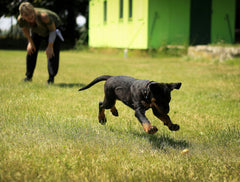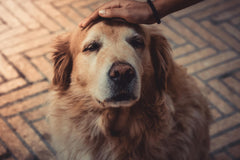
Training your new puppy to walk with a dog leash on is a fun yet intimidating task to take on as a new dog parent. Puppies are wild and full of energy at almost all times. Making it difficult to slow them down long enough to teach them something new, like walking on a leash. There are a few tips that experts have shared, about teaching a new puppy to walk appropriately by your side on a leash. Teaching them while they are a puppy, rather than a full-grown dog, is a very important step in this whole process.
Let Them Become Familiar with the Equipment

Allowing a puppy or even a grown dog to sniff new equipment or toys before interacting with them is super important. Putting a collar or halter on a dog for the first time can easily become a traumatic experience for them if they are forced to wear it without being able to just check it out first.
This shouldn’t be a long or complicated process. Simply hold the new collar, harness, or leash out to your dog and allow them to sniff it and see that it’s not dangerous or harmful for them. You won’t want to leave the collar or leash just lying around because they may begin to think that these items are a new toy for them to play with rather than equipment.
Begin with Just the Collar

When beginning to train your dog to walk on a leash, you will want to take this process one step at a time. Once you’ve allowed your dog to sniff their new collar, you can put it on them. Allow your dog to wear their collar around the house just to give them some time to get used to the feeling of having it on before attaching a leash and heading outside.
Most dog owners should always have a collar on their dog. A collar that includes tags that identify who the dog is and where it lives, because you never know when they might decide that it’s the perfect opportunity for them to do off for a run or chase after a car. It’s important to get your dog used to wearing their collar all the time, be it a regular collar with tags or a GPS tracking collar. Then proceed to getting them used to having a leash attached to it.
Make Sure the Leash is the Right Size

You may be surprised to find out that there are different sized leashes that go with different sized dogs as well as walking styles. Smaller nylon leashes are good for smaller breeds of dogs, while you may want a stronger leather leashes might be appropriate for larger, stronger dogs.
The length of the leash is also something to take into consideration. Generally, a 6-foot-long leash is a good dog training leash for an excitable pup who’s learning how to walk on a leash. This length leash allows for them to jump around and explore while still staying close by to you.
Consider Using a Harness if they Tend to Pull

Harnesses are good for a dog pulling on leash. There are “no-pull harnesses” that are good for strong young pups or even grown dogs, who would rather drag you down the street at top speed than walk by your side at your pace. These kinds of harnesses clip to the leash on the front at their chest. That way, if they begin to pull it turns their body around to face you, the person holding the leash. This is a great way to train your dog to walk on a leash and not pull or try to run away from you.
Conclusion
Training your dog or puppy to walk on a leash is an exciting experience that allows you and your buddy to bond and spend time together. It can be challenging to leash train both puppies and older dogs who have never been on a leash or even worn a collar consistently before. Once you and your dog get into a good rhythm of taking walks together you both will have something fun to look forward to each day.
How to train a dog to walk on a leash?
How to leash train a puppy?
How to walk a dog?
Related Posts:
- What You Need to Know About Hiking with Dogs
- Best Dog Supplies to Get for Your Dog
- Best Puppy Supplies According to Vets




